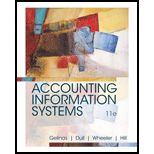
Accounting Information Systems
11th Edition
ISBN: 9781337552127
Author: Ulric J. Gelinas, Richard B. Dull, Patrick Wheeler, Mary Callahan Hill
Publisher: Cengage Learning
expand_more
expand_more
format_list_bulleted
Concept explainers
Question
Chapter 11, Problem 5RQ
Summary Introduction
To explain: The electronic bill presentment and payment (EBPP) systems.
Introduction:
B/AR/CR process:
It is an accounting process with an interacting structure of different process supporting the decision-making activities of the
Expert Solution & Answer
Want to see the full answer?
Check out a sample textbook solution
Students have asked these similar questions
The Weighted Average Cost of Capital (WACC) includes:
A) Cost of equity and cost of debtB) Only the cost of equityC) Only the cost of debtD) Total revenue of the company
Which of these is NOT part of the 4Ps in marketing but relevant to finance?
A) PriceB) PromotionC) PlaceD) Profitability
I need correct answer.
If a bond’s price increases, its yield will:
A) IncreaseB) DecreaseC) Remain the sameD) Be unpredictable
Chapter 11 Solutions
Accounting Information Systems
Ch. 11 - What is the billing/accounts receivable/cash...Ch. 11 - What primary activities does the B/AR/CR process...Ch. 11 - Prob. 3RQCh. 11 - What functions are typically segregated in the...Ch. 11 - Prob. 5RQCh. 11 - Describe several ways that companies have reduced...Ch. 11 - Prob. 7RQCh. 11 - Prob. 8RQCh. 11 - Prob. 9RQCh. 11 - What is accounts receivable master data?
Ch. 11 - What are the major features of a balance-forward...Ch. 11 - What are the differences between a post-billing...Ch. 11 - Prob. 13RQCh. 11 - Prob. 14RQCh. 11 - What characterizes a valid RA (i.e., cash...Ch. 11 - Prob. 16RQCh. 11 - Prob. 17RQCh. 11 - Develop several examples of possible goal...Ch. 11 - Prob. 2DQCh. 11 - Prob. 3DQCh. 11 - Prob. 4DQCh. 11 - Prob. 5DQCh. 11 - The two most widely used billing systems are (1)...Ch. 11 - Prob. 7DQCh. 11 - Prob. 1SPCh. 11 - Prob. 2SPCh. 11 - Prob. 3SPCh. 11 - Prob. 5SPCh. 11 - Prob. 6SPCh. 11 - Prob. 3PCh. 11 - Prob. 5PCh. 11 - Prob. 6PCh. 11 - Use the DFDs in Figure 11.3 (pg. 416), Figure 11.4...
Knowledge Booster
Learn more about
Need a deep-dive on the concept behind this application? Look no further. Learn more about this topic, finance and related others by exploring similar questions and additional content below.Similar questions
- What is the primary goal of financial management? A) Maximizing revenuesB) Minimizing costsC) Maximizing shareholder wealthD) Increasing market share need help!arrow_forwardThe time value of money concept assumes that: A) A dollar today is worth more than a dollar in the future B) A dollar in the future is worth more than a dollar today C) Money loses value only when interest rates rise D) Money value remains constant over time need help!!arrow_forwardWhat does ROI stand for in finance? A) Return on InvestmentB) Revenue on InvestmentC) Rate of InterestD) Risk of Investment need answer!arrow_forward
- The time value of money concept assumes that: A) A dollar today is worth more than a dollar in the futureB) A dollar in the future is worth more than a dollar todayC) Money loses value only when interest rates riseD) Money value remains constant over timearrow_forwardWhat is the primary goal of financial management? A) Maximizing revenuesB) Minimizing costsC) Maximizing shareholder wealthD) Increasing market sharearrow_forwardA bond’s face value is: A) The price at which the bond is bought B) The amount paid to the bondholder at maturity C) The interest rate of the bond which option is correct?arrow_forward
- What does ROI stand for in finance? A) Return on InvestmentB) Revenue on InvestmentC) Rate of InterestD) Risk of Investmentneed exparrow_forwardA bond’s face value is: A) The price at which the bond is bought B) The amount paid to the bondholder at maturity C) The interest rate of the bond D) The amount of annual coupon paymentsi need help in this question!arrow_forwardA bond’s face value is: A) The price at which the bond is bought B) The amount paid to the bondholder at maturity C) The interest rate of the bond D) The amount of annual coupon paymentsarrow_forward
- A public company’s value can be calculated by different approaches depending on the data available and are often shared through quarterly or annual reports, or financial statements. If a financial and investment analyst for a publicly traded company, understanding that I may be asked to give a presentation on how the company uses performance metrics in corporate valuation. How would I present return on equity (ROE) and earnings per share (EPS) to a group of investors or senior management. Reviewiing a publicly traded company’s ROE and EPS. Although What do these results say about the company?arrow_forwardA stock’s beta coefficient is a measure of its: A) Dividend yield B) Risk in relation to the market C) Earnings growth rate D) Market pricearrow_forwardNo AI Which of the following is NOT a characteristic of common stock? A) Voting rights B) Dividends C) Guaranteed return on investment D) Ownership in the companyarrow_forward
arrow_back_ios
SEE MORE QUESTIONS
arrow_forward_ios
Recommended textbooks for you
 College Accounting (Book Only): A Career ApproachAccountingISBN:9781337280570Author:Scott, Cathy J.Publisher:South-Western College Pub
College Accounting (Book Only): A Career ApproachAccountingISBN:9781337280570Author:Scott, Cathy J.Publisher:South-Western College Pub- Principles of Accounting Volume 2AccountingISBN:9781947172609Author:OpenStaxPublisher:OpenStax College
 Intermediate Financial Management (MindTap Course...FinanceISBN:9781337395083Author:Eugene F. Brigham, Phillip R. DavesPublisher:Cengage Learning
Intermediate Financial Management (MindTap Course...FinanceISBN:9781337395083Author:Eugene F. Brigham, Phillip R. DavesPublisher:Cengage Learning



College Accounting (Book Only): A Career Approach
Accounting
ISBN:9781337280570
Author:Scott, Cathy J.
Publisher:South-Western College Pub


Principles of Accounting Volume 2
Accounting
ISBN:9781947172609
Author:OpenStax
Publisher:OpenStax College

Intermediate Financial Management (MindTap Course...
Finance
ISBN:9781337395083
Author:Eugene F. Brigham, Phillip R. Daves
Publisher:Cengage Learning